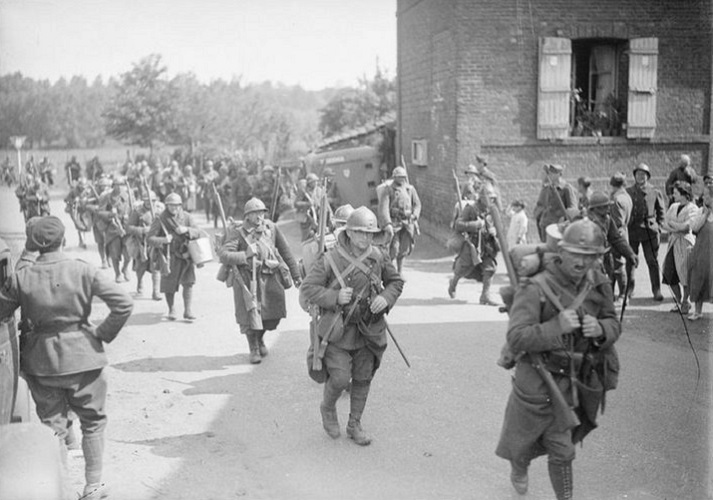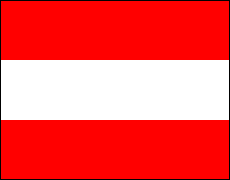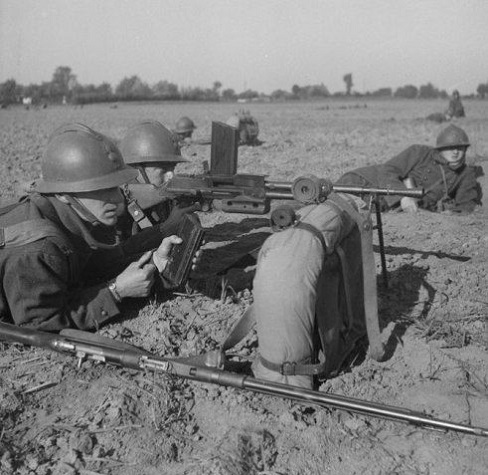● ● ●
In May
1940 the French Army embodied 101 infantry divisions (Division
d'Infanterie or DI), of which 91 were located in
metropolitan France. They were classified by composition as
Series A, B or C, and by organization and equipment as
Northeast, Fortress or Overseas (i.e. stationed in the
colonies). Several Northeast divisions assigned to the Army
of the Alps on the frontier with Italy carried the
unofficial designation Mountain (Division Alpine).
The
Series A divisions were regular formations that were
maintained in peacetime at two-thirds strength. Upon
mobilization they were brought up to full strength with
reserve units. The Series B divisions were maintained in
peacetime with only a small regular cadre; on mobilization
they too were brought up to strength with reserve units. In
peacetime Series C divisions existed only on paper,
consisting entirely of reserve units. Series A divisions
embodied regular soldiers and the youngest reservists,
Series B divisions a mix of younger and older reservists
(aged 30 and above) and Series C divisions mostly older reservists.
The
Northeast organization applied to all infantry divisions in
metropolitan France except mountain and fortress divisions.
Regardless of classification, however, all infantry
divisions had the same basic triangular organization: three
infantry regiments, each with three battalions. The
Northeast infantry division was the most numerous type and
it was quite similar to the
German 1st Wave infantry
division. The principal points of difference concerned the
divisional artillery and antitank units.

French infantry at Dunkirk, May 1940
(Imperial War Museum)
After
World War I, the French Army was left with enormous
stockpiles of weapons. This made it hard to justify an
upgrade of the artillery so instead the existing weapons
were modernized. Thus in the French infantry division, the
famous M1898 75mm field gun was still in service in 1939—36
of them in a light artillery regiment. Despite its age the
75mm remained a reasonably effective field gun, but it could
not deliver a weight of fire equivalent to the German
infantry division’s 36 x 105mm light field howitzers, which
had replaced the 77mm field gun of WW I vintage. (Germany,
having been compelled by the terms of the Treaty of
Versailles to discard most of its weaponry, did not possess a huge reserve of obsolescent weapons.) Another problem
was that the French 75mm gun was not capable of high-angle
fire—a considerable handicap by comparison with the German
105mm howitzer. However, this deficiency was somewhat offset
by the French division’s 24 x 155mm howitzers (versus 12 x
150mm howitzers in the German division).
As for
antitank guns (ATG), the Northeast infantry division had a
total of thirty, distributed among the three infantry
regiments, the divisional reconnaissance battalion and two
independent companies. In most divisions there were 22 x
25mm ATG and, usually, 8 x 47mm ATG. One of the independent
companies had 12 x 25mm ATG and the other had either 8 x
47mm ATG, 2 x 75mm and 6 x 47mm ATG, or 6 x 75mm ATG. The
75mm ATG was a modified M1898 field gun. The 25mm AT company
was usually attached to one of the infantry regiments and
the 47mm ATG company was always attached to the light
artillery regiment. Thus the French infantry division had
significantly fewer ATG than the 75 x 37mm in the German
infantry division.

Command Flag for Generals Commanding a
Division
The
divisional reconnaissance battalion was “mixed mobility,”
with a cavalry company, a motorcycle company and a motorized
heavy weapons company (heavy machine guns and ATG): broadly
similar to its German counterpart albeit with a higher level
of motorization and less firepower.
The
foregoing description applies mainly to the Series A
Northeast infantry divisions, which embodied active soldiers
and the most recently trained reservists, and had the latest
equipment. Besides being manned by older reservists, most of
the Series B and C divisions lacked various components and
they generally were armed with older weapons, e.g. the 8mm M1915 Chauchat light machine gun (LMG) and unmodernized 75mm field
guns. In many cases a single “mixed” artillery regiment with
three 75mm field gun battalions and one 155mm howitzer
battalion replaced the light and heavy artillery regiments.
The 25mm ATG company was often missing, and mortars and
heavy machine guns were in short supply.

French infantry with an FM 24/29 LMG
(Musée de l'Armée)
The
fortress infantry divisions (Division d'Infanterie de
Forteresse or DIF) originated as Fortified Sectors, i.e.
the Maginot Line and its extensions. These fortifications
had troops permanently assigned to them and in early 1940
they were given divisional identities. The 102nd DIF, for
example, was formed from the troops of Ardennes Defensive
Sector. It consisted of the 148th Fortress Infantry
Regiment, 42nd Colonial Machine Gun Demi-Brigade, the 52nd
Colonial Machine Gun Demi-Brigade, the 3rd Machine Gun
Battalion, the 160th Artillery Regiment and the 218th Artillery
Regiment. (Demi-Brigade was the French term of a
regiment-sized unit made up of battalions with an
independent
identity.)
In the
initial phase of the 1940 campaign, many infantry divisions
suffered high losses or were largely destroyed. In early
June their remnants were used to form new light infantry
divisions (Division Légère d'Infanterie or DLI), most
of which had the approximate strength of a brigade. The 59th
DLI, for example, was formed with remnants of the 55th and
71st DIs. It had two understrength infantry regiments, a
mixed artillery regiment and a few ATG. The 59th DLI fought
in the second phase of the campaign, surrendering to the
Germans on 10 June.
When the
armistice came into effect on 25 June, the Army in
metropolitan France laid down its arms, and hundreds of
thousands of French soldiers went into German captivity. The
terms of the armistice allowed the Vichy government to
maintain only eight infantry divisions plus corps troops in
unoccupied France, and these units had roughly the
organization of the 1939-40 infantry division.